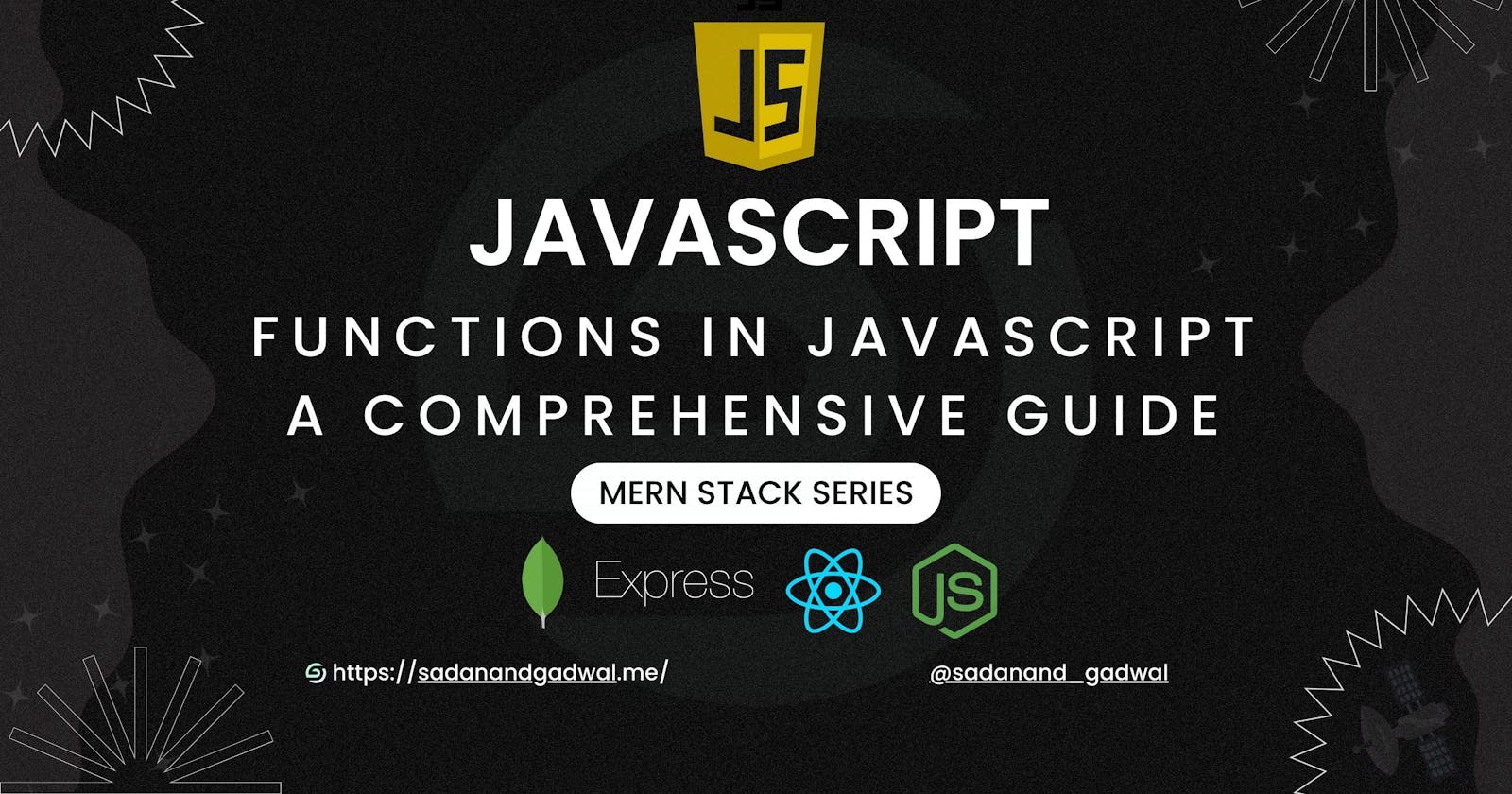Functions in JavaScript: A Comprehensive Guide
Understanding Declaration, Parameters, Return Statements, Function Expressions, Arrow Functions, and More
Functions are a fundamental concept in JavaScript, allowing developers to encapsulate code for reuse, organization, and abstraction. In this guide, we’ll explore various aspects of functions in JavaScript, including their declaration, parameters, return statements, function expressions, and arrow functions.
1. Declaration of Functions
In JavaScript, functions can be declared using the function keyword followed by the function name and a pair of parentheses () containing optional parameters.
Here's a basic example:
function greet(name) {
return `Hello, ${name}!`;
}
console.log(greet('sadanand gadwal')); // Output: Hello, sadanand gadwal!
- The greet function is declared using the function keyword. It takes a parameter name and returns a greeting message using string interpolation.
2. Parameters
Functions can accept parameters, which are variables that hold the values passed to the function when it is called. Parameters are declared within the parentheses following the function name.
Here’s an example:
function add(a, b) {
return a + b;
}
console.log(add(5, 3)); // Output: 8
The
addfunction takes two parametersaandband returns their sum.The
subtractfunction takes two parametersaandband returns the result ofa - b.
3. Return Statements
Functions can use the return statement to send a value back to the code that called the function. If a function doesn't explicitly return a value, it implicitly returns undefined.
Here's an example:
function subtract(a, b) {
return a - b;
}
console.log(subtract(10, 4)); // Output: 6
- Both
addandsubtractfunctions use thereturnstatement to return the result of the arithmetic operation.
4. Function Expressions
Function expressions define functions as part of an expression, rather than as a declaration. They can be named or anonymous and are often used to assign functions to variables.
Here’s an example of a named function expression:
const multiply = function multiply(a, b) {
return a * b;
};
console.log(multiply(7, 8)); // Output: 56
And here’s an example of an anonymous function expression:
const divide = function(a, b) {
return a / b;
};
console.log(divide(100, 5)); // Output: 20
The
multiplyfunction is defined using a named function expression. The function is assigned to the variablemultiply.The
dividefunction is defined using an anonymous function expression. The function is assigned to the variabledivide.
5. Arrow Functions
Arrow functions are a more concise way to write functions in JavaScript, introduced in ES6. They have a more compact syntax and automatically bind this to the surrounding code's context. Here's an example:
const square = (x) => {
return x * x;
};
console.log(square(4)); // Output: 16
For simple functions that have only one expression in the body, the curly braces and return keyword can be omitted:
const cube = (x) => x * x * x;
console.log(cube(3)); // Output: 27
The
squarefunction is defined using an arrow function. It takes a parameterxand returns the square ofx.The
cubefunction is also defined using an arrow function, but with a more concise syntax since it has only one expression in its body.
6. Example: Using Functions
function calculate(operation, a, b) {
switch (operation) {
case 'add':
return add(a, b);
case 'subtract':
return subtract(a, b);
case 'multiply':
return multiply(a, b);
case 'divide':
return divide(a, b);
default:
return 'Invalid operation';
}
}
console.log(calculate('add', 5, 3)); // Output: 8
console.log(calculate('multiply', 4, 6)); // Output: 24
console.log(calculate('divide', 10, 2)); // Output: 5
console.log(calculate('power', 2, 3)); // Output: Invalid operation
The
calculatefunction takes three parameters:operation,a, andb. It uses aswitchstatement to determine which operation to perform (add,subtract,multiply,divide) and calls the corresponding function with the given arguments.The
switchstatement also handles the case when an invalid operation is provided, returning an error message.
Conclusion
Functions are a powerful feature in JavaScript, allowing developers to write modular and reusable code. Understanding the different ways to declare and use functions is essential for any JavaScript developer.
Bonus : Complete code :-
// Declaration of Functions
function greet(name) {
return `Hello, ${name}!`;
}
// Parameters
function add(a, b) {
return a + b;
}
// Return Statements
function subtract(a, b) {
return a - b;
}
// Function Expressions
const multiply = function multiply(a, b) {
return a * b;
};
const divide = function(a, b) {
return a / b;
};
// Arrow Functions
const square = (x) => {
return x * x;
};
const cube = (x) => x * x * x;
// Example: Using Functions
function calculate(operation, a, b) {
switch (operation) {
case 'add':
return add(a, b);
case 'subtract':
return subtract(a, b);
case 'multiply':
return multiply(a, b);
case 'divide':
return divide(a, b);
default:
return 'Invalid operation';
}
}
console.log(greet('sadanand gadwal')); // Output: Hello, sadanand gadwal!
console.log(add(5, 3)); // Output: 8
console.log(subtract(10, 4)); // Output: 6
console.log(multiply(7, 8)); // Output: 56
console.log(divide(100, 5)); // Output: 20
console.log(square(4)); // Output: 16
console.log(cube(3)); // Output: 27
console.log(calculate('add', 5, 3)); // Output: 8
console.log(calculate('multiply', 4, 6)); // Output: 24
console.log(calculate('divide', 10, 2)); // Output: 5
console.log(calculate('power', 2, 3)); // Output: Invalid operation
Playground for JavaScript
Playcode.io is an online code editor and playground that allows users to write, edit, and execute HTML, CSS, and JavaScript code.
🌟 Stay Connected! 🌟
Hey there, awesome reader! 👋 Want to stay updated with my latest insights,Follow me on social media!
